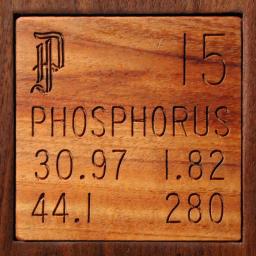Phosphorus is a nonmetal, discovered by the German physician Hennig Brand in 1669 (Stwertka, 64). He performed experiments in the tradition of old chemists. He distilled the residue from urine which was boiled down and obtained a substance which burst into flame when in warm air, and glowed in the dark. This discovery was actually white phosphorous, a waxy, white solid which melts at 44 degrees Celsius. The name of Phosphorus was taken from the Greek word, “phosphorous”, or “bearer of light”.
Industrially, two forms of Phosphorus have significance. White and red phosphorus are used internationally, and white phosphorus accounts for 99% of the worldwide demand.

(Left to Right) White Phosphorus (Yellow Cut), Red Phosphorus, Violet Phosphorus
Phosphoric acid and the phosphates are widely used. White phosphorus is elemental phosphorus, and is produced mostly in the U.S., China, and Kazakhstan.
Phosphorus calls group 15 home, and is in period 3, block P. The atomic number of Phosphorus is fifteen. Phosphorus exists as a solid when it is in room temperature areas. The electron configuration of Phosphorus is 1s2,2s2,2p6,3s2,3p3, or [Ne]3s2,3p3. The melting point is 44.15 C, 111.47 F, 317.3 K, and the boiling point is 280.5 C, 536.9 F, 553.7 K. The atomic radius is 1.80, while the covalent radius sits at 1.09.
All of these elements are significant in one way or another. The properties and unique abilities make them important, and vital to progression in the field of chemistry. They are also useful in several other applications, ranging from creating household items, to aiding in the completion of industrial projects.


